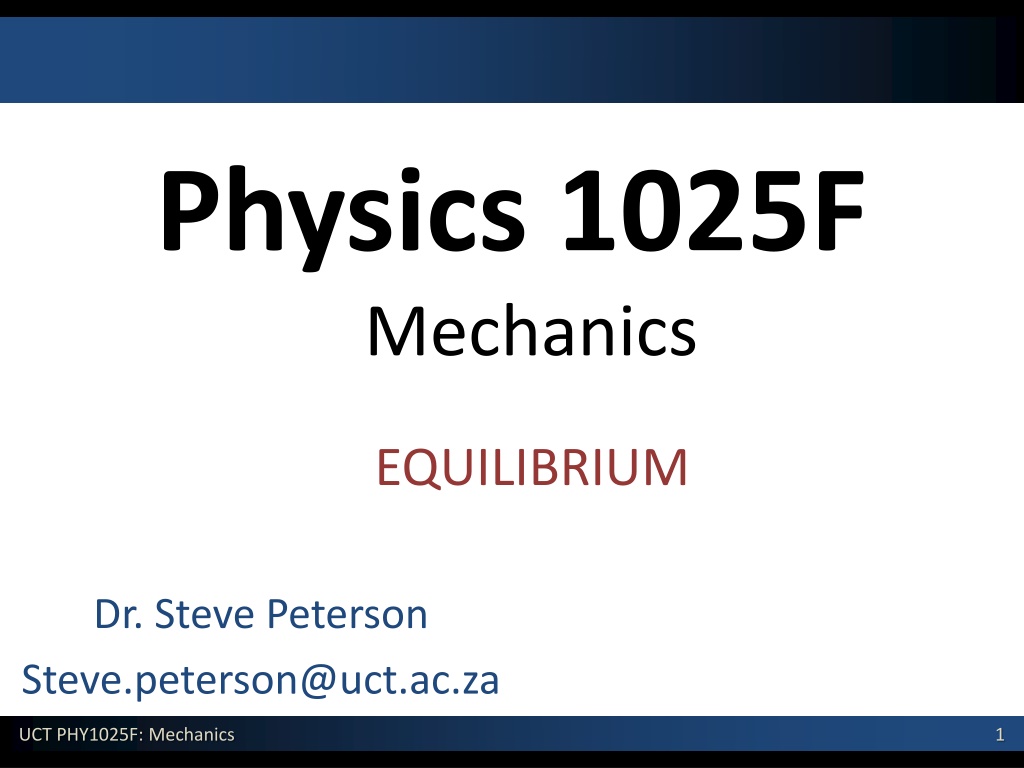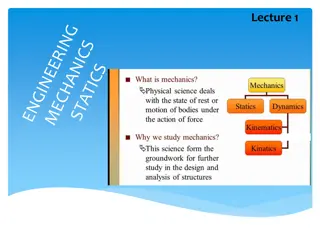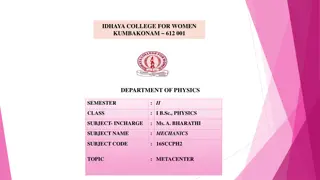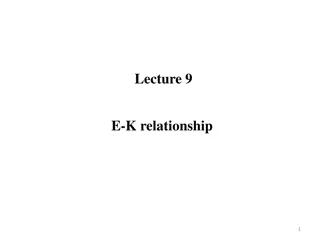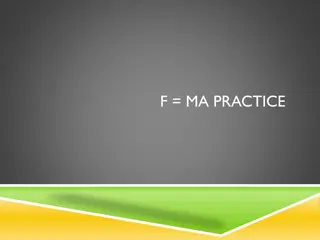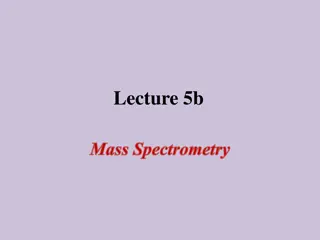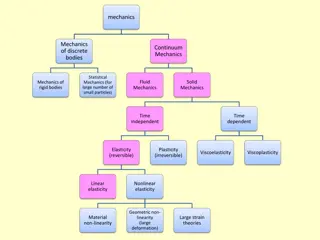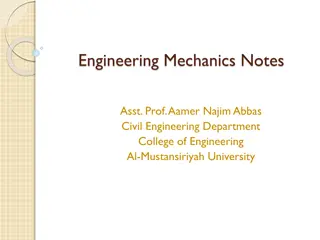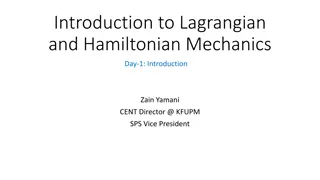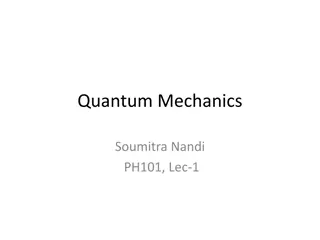Understanding Centre of Mass in Mechanics
Explore the concept of Centre of Mass in mechanics, crucial for understanding the motion of extended bodies. Learn how to calculate the Centre of Mass for different body shapes and its significance in maintaining stability. Discover its role in complex systems with multiple particles and positions.
Download Presentation

Please find below an Image/Link to download the presentation.
The content on the website is provided AS IS for your information and personal use only. It may not be sold, licensed, or shared on other websites without obtaining consent from the author. Download presentation by click this link. If you encounter any issues during the download, it is possible that the publisher has removed the file from their server.
E N D
Presentation Transcript
Physics 1025F Mechanics EQUILIBRIUM Dr. Steve Peterson Steve.peterson@uct.ac.za UCT PHY1025F: Mechanics 1
Chapter 7: Centre of Mass Until now, we have assumed that motion of an extended object could be approximated as a point particle or only undergoes translational motion UCT PHY1025F: Mechanics 2
Centre of Mass For real extended bodies (particularly if they are undergoing rotation) it is important to know the point where we may consider all the mass to be located. This point is known as the centre of mass". UCT PHY1025F: Mechanics 3
Centre of Mass Gravity, for example, will act as if all the mass were located at the centre of mass for this reason the point is sometimes also referred to as the centre of gravity. The general motion of an object can be considered as the sum of the translational motion of the CM, plus rotational, vibrational, or other forms of motion about the CM. UCT PHY1025F: Mechanics 4
Centre of Mass For symmetrical bodies the centre of mass is at the centre of symmetry. UCT PHY1025F: Mechanics 5
Centre of Mass For irregularly shaped bodies the center of mass is best obtained experimentally. UCT PHY1025F: Mechanics 6
Centre of Mass To be stable, the centre of mass must lie above the base of support. UCT PHY1025F: Mechanics 7
Centre of Mass Consider a system made up of two particles of masses mA and mB, both lying along the x-axis at positions xA and xB. Let s calculate the centre of mass. A x y B x x m CM x m A B + m x m x For two particles, the center of mass lies closer to the one with the most mass. = CM x A m A B B + m A B UCT PHY1025F: Mechanics 8
Centre of Mass Now let s consider a body composed of masses m1, m2, m3 located at three different positions. m M M m m = + + R r r r 1 2 3 1 2 3 CM M m m m = + + 1 2 3 X x x x 1 2 3 CM M M M m m m = + + 1 2 3 Y y y y 1 2 3 CM M M M UCT PHY1025F: Mechanics 9
Chapter 8: Rotational Motion From Newton s second law, we see that a force will cause a body to accelerate. What causes a body to undergo a rotational acceleration? UCT PHY1025F: Mechanics 10
Rotational Equivalent of Force Newton s Second Law tells us that a force produces an acceleration. = F a m Can a force also produce an angular acceleration or is something else required? Let s look at opening a door, which requires a rotational acceleration. UCT PHY1025F: Mechanics 11
Opening the Door = F F , r r 1 2 1 2 The magnitude of the applied force determines how quickly the door opens. UCT PHY1025F: Mechanics 12
Opening the Door = F F , r r 1 2 1 2 The location of the applied force makes a difference, with different locations producing different accelerations. Therefore it appears that the distance r from the axis of rotation is important. UCT PHY1025F: Mechanics 13
Opening the Door The direction of the force is also important. The force applied perpendicularly to the door is most effective in achieving rotational acceleration, that at 45 is less effective while the force parallel to the door won t produce any rotation at all! UCT PHY1025F: Mechanics 14
Opening the Door Therefore the ability to cause rotational acceleration depends on both the magnitude of the applied force, F, and the perpendicular distance to the line of action of the force. r from the axis of rotation UCT PHY1025F: Mechanics 15
Opening the Door Therefore the ability to cause rotational acceleration depends on both the magnitude of the applied force, F, and the perpendicular distance from the axis of rotation to the line of action of the force. l UCT PHY1025F: Mechanics 16
Torque r F This product of the two, , is referred to as the torque , , while is referred to as the moment arm or lever arm . Therefore torque is given by sin Fr r F = = r = sin F r F r = = or F r F r = r F Cross Product: Another form of Vector Multiplication UCT PHY1025F: Mechanics 17
Torque = = or F r F r Torque, , is the tendency of a force to rotate an object about some axis. is torque and represented by the Greek symbol, tau F is the applied force r is the length of the position vector SI unit is N.m UCT PHY1025F: Mechanics 18
Direction of Torque Torque is a vector quantity The direction is perpendicular to the plane determined by the position vector and the force . If the turning tendency of the force is counterclockwise, the torque will be positive. If the turning tendency (F1) is clockwise, the torque will be negative . UCT PHY1025F: Mechanics 19
Example: Torque Revolutionaries attempt to pull down a statue of the Great Leader by pulling on a rope tied to the top of his head. The statue is 17 m tall, and they pull with a force of 4200 N at an angle of 65 to the horizontal. What is the torque they exert on the statue? If they are standing to the right of the statue, is the torque positive or negative? UCT PHY1025F: Mechanics 20
Torque If more than one torque acts on a body then it is the net torque acting on the body which will determine whether the body undergoes rotational acceleration or not. = net= I If , clock = anticlock = 0 net Rotational Equilibrium If , clock anticlock 0 net UCT PHY1025F: Mechanics 21
Example: Torque A 2 kg and a 3 kg hang from the left hand side of a beam balance as shown below where must a 4 kg be hung to balance these two weights? UCT PHY1025F: Mechanics 22
Chapter 9: Static Equilibrium Statics is concerned with the calculation of the forces acting on and within structures that are in equilibrium UCT PHY1025F: Mechanics 23
The Conditions for Equilibrium An object with forces acting on it, but that is not moving, is said to be in equilibrium. The first condition for equilibrium is that the forces along each coordinate axis add to zero. The second condition of equilibrium is that there be no torque around any axis; the choice of axis is arbitrary. UCT PHY1025F: Mechanics 24
Solving Statics Problems 1. Choose one object at a time, and make a free-body diagram showing all the forces on it and where they act. 2. Choose a coordinate system and resolve forces into components. 3. Write equilibrium equations for the forces. 4. Choose any axis perpendicular to the plane of the forces and write the torque equilibrium equation. A clever choice here can simplify the problem enormously. 5. Solve. UCT PHY1025F: Mechanics 25
Solving Statics Problems If a force in your solution comes out negative, it just means that it s in the opposite direction from the one you chose. This is trivial to fix, so don t worry about getting all the signs of the forces right before you start solving. If there is a cable or cord in the problem, it can support forces only along its length. Forces perpendicular to that would cause it to bend. UCT PHY1025F: Mechanics 26
Example: Static Equilibrium Determine the force exerted by the biceps muscle on the forearm when supporting a 5.0-kg mass in the hand, 25.0 cm from the elbow. The biceps muscle is attached to the forearm 5.0 cm from the elbow joint, the weight of the forearm is 20.0 N and its centre of mass is 15.0 cm from the joint. UCT PHY1025F: Mechanics 27
Example: Static Equilibrium A woman bends from the hip to lift an 80.0-N weight. The forces acting on her spine are represented schematically in the diagram below. The upper part of her body has a weight of 235 N, Tis the force exerted by the back muscle on the spine, and H is the force of hips on the spine. Applying the condition of static equilibrium, determine the magnitudes of H and T. UCT PHY1025F: Mechanics 28
Example: Static Equilibrium A 25 kg uniform bar, 10.0 m in length, is fixed to a wall on one side and is supported in a horizontal position by a steel wire attached to the other end. A mass of 15 kg is hung from the bar at a distance of 7.5 m from the fixed end. What is the tension in the wire and the magnitude of the force exerted by the wall on the bar at A? How would the tension in the wire change if the weight were moved closer to the wall? UCT PHY1025F: Mechanics 29
Example: Static Equilibrium To paint a wall a painter (mass 85.5 kg) places a 5.60 m board (mass 15.3 kg symmetrically on top of two supports 4.20 m apart (see diagram below). If the painter stands on the board 1.15 m from the right-hand support what are the magnitudes of the forces exerted by the two supports on the board? The painter now moves slowly to the right. How close to the end of the board can he move before it begins to tip? UCT PHY1025F: Mechanics 30
